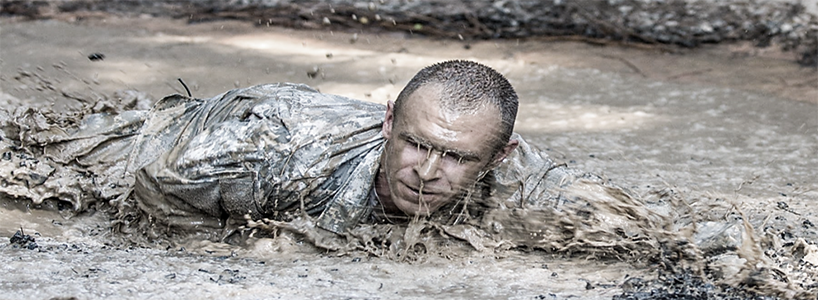Ernest Hemingway’s “Soldier’s Home” tells about the struggles of a World War I Veteran’s transition from the war front to the home front. Tension between Krebs, the Veteran, and his family reaches intolerable levels. “’Your father is worried,’” Krebs mother tells him. “’He thinks you have lost your ambition, that you haven’t got a definite aim in life. . . . The boys are all settling down; they’re all determined to get somewhere . . . boys like Charley Simmons are on their way to being really a credit to the community.’”
Krebs’ problem isn’t just getting a job. Krebs’ challenge is longer-term. Veterans’ reintegration into communities after serving the nation has always been challenging—for Veterans and communities, alike. Shorter-term views of Veteran reintegration focus on return and employment. The Center for New American Security’s (CNAS) study released the day before Veterans Day, “Onward and Upward,” takes longer-term view and begins to answer important questions for Veterans and employers that for too long have not only gone unanswered, but also gone unasked.
A LONG VIEW
“Onward and Upward: Understanding Veteran Retention and Performance in the Workplace” serves both employers and Veterans and normalizes an understanding of Veterans and Veterans in the workforce. As the study explains, it looks “beyond initial hiring data to examine the behavior of veterans in the workforce, including retention and performance, as well as corporate perceptions of how veterans perform once hired.”
A detailed understanding of Veterans and longer-term employment performance is important. It’s important for employers who want and need to know if they can depend on Veterans they hire. It’s important for Veterans—both employed and those looking—so they have some informed context about expectations and their role as a civilian employee in a competitive workforce. Succeeding in the civilian world takes tactics and strategies that don’t always work so well in the military world. Suddenly, you and your preferences and expectations matter.
FOR VETERANS
“Onward and Upward” is a must-read for Servicemembers preparing to transition and those already in the process, or beyond. These days, Veteran unemployment rates are recovering nicely from a mid-2011 disastrous peak. As Secretary McDonald pointed out at Arlington on Veterans Day, “Veteran unemployment’s dropped by over half in the last five years. Unemployment for Post-9/11 Veterans has dropped by 70 percent.” In fact, Veterans are now doing better than their non-Veteran counterparts. Great news.
But it is surely about more than getting a job at the start. Success for Veterans is about keeping jobs, growing, progressing, promotion, thriving. And all that’s complicated, and Veteran performance in those regards hasn’t yet been entirely clear. Narrower examinations on simple employment and retention—that, perhaps, indicate that Veterans don’t hang around very long once hired—do not tell the whole story and may do a disservice to Veterans and employers alike.
One thing among many that “Onward and Upward” tells us is “that veterans are likely to leave their first job out of service relatively quickly, but their reasons differ widely. Most leave jobs for greener pastures – higher salaries, more responsibility, or a better fit – in positive ways that mirror non-veterans. A minority leave jobs for negative reasons . . . .” In other words, you Veteran employees out there may not be much different from their non-Veteran counterparts. You find a job, try it out for a while. If you like the job and the profession, you may stay. If you like the profession but not the particular job so much—or the salary just isn’t cutting it—then, like your peers, you find a better fit.
As a Veteran myself, I know this is important to understand. We tend to think that quitting anything is bad—our work ethic is about loyalty and suffering through hardships. In the civilian workforce, work ethic is important, but moving around periodically is simply a matter of business, and longer-term success.
FOR EMPLOYERS
And it’s a must-read for employers looking to hire Veterans, some of the most eligible, valuable, and reliable talent in the job market. Employers tentative about hiring Veterans because they believe Veterans are some sort of unknown quantity may be both deceiving themselves and missing out on a great asset for their organizations. The CNAS report indicates “lower turnover among veterans once they have found the correct fit, indicating that securing a role in a desired field is one of the strongest factors increasing retention of veterans.” Further, CNAS reports, “Studies have documented its economic value to society, as well as the greater aggregate profitability of firms that hire veterans.”
Hiring a good, new employee is risky—he or she might not stay around long, for a host of reasons. But that’s true of non-Veterans and Veterans alike. However, the numbers indicate that a good choice with the right Veteran can payoff in the mid- to long-term.
CHALLENGES
There are challenges, of course, for both Veterans and employers. However, understanding the challenges and working around them as a Veteran and as an employer can benefit both. And CNAS offers a range of recommendations worth considering. Transition isn’t easy, and it never has been.
It may never be easy, but that doesn’t mean Veterans can’t transition with spectacular success. Indeed, spectacular success in the face of daunting odds is one of the hallmarks of American Veterans. Post-transition, that means an aim in life, settling down, getting somewhere, and being credits to their communities.




